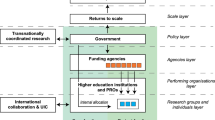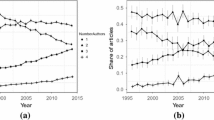Abstract
We investigate the impact of collaborative research in academic Finance literature to find out whether and to what extent collaboration leads to higher impact articles (6,667 articles across 2001–2007 extracted from the Web of Science). Using the top 5 % as ranked by the 4-year citation counts following publication, we also follow related secondary research questions such as the relationships between article impact and author impact; collaboration and average author impact of an article; and, the nature of geographic collaboration. Key findings indicate: collaboration does lead to articles of higher impact but there is no significant marginal value for collaboration beyond three authors; high impact articles are not monopolized by high impact authors; collaboration and the average author impact of high-impact articles are positively associated, where collaborative articles have a higher mean author impact in comparison to single-author articles; and collaboration among the authors of high impact articles is mostly cross-institutional.

Similar content being viewed by others
Notes
In some disciplines such as clinical medicine, there may not be significant differences between citation counts on articles published in journals of high, moderate and low impact factors (Falagas et al. 2010).
The sub-samples of different types of article are independent because given that citations are based on an article and not directly attributed to authors per se, the probability of observing a particular citation count, say, for a single-author article, is independent of the probability of observing the citation count for an article with two-authors where one of the authors is the same person as that of the single-author article. In other words, we maintain that we cannot predict the citation count for one type of article based on our knowledge of the citation count for another type of article.
Annual mean citation counts for each of the seven publication years in the study indicate a steady rise over the 4 years following publication (numbers are available from the authors).
A comparison between type 1 and type 5 articles was not attempted because there are only three observations in the latter type in the sub-sample of top 5 %.
Given that Europe comprises the second largest continental affiliation, mathematically we would expect to see its corresponding annual proportions move in the opposite direction to that of North America.
Bordons et al. (1996) report on the relationship between types of collaboration in Biomedicine research emanating from Spain and expected impact factors. Expected impact factors under international collaboration are significantly higher compared to domestic or local collaborations. Bordons et al. also report that international collaboration leads to higher visibility for Spanish scientists because they publish in higher impact journals.
References
Abt, H. A. (1984). Citations to single and multiauthored papers. Publications of the Astronomical Society of the Pacific, 96(583), 746–749.
Avkiran, N. K. (1997). Scientific collaboration in finance does not lead to better quality research. Scientometrics, 39(2), 173–184.
Beaver, D. B. (1986). Collaboration and teamwork in Physics. Czechoslovak Journal of Physics B, 36(1), 14–18.
Beaver, D. B. (2001). Reflections on scientific collaboration (and its study): past, present, and future. Scientometrics, 52(3), 365–377.
Bordons, M., Gómez, I., Fernández, M. T., Zulueta, M. A., & Méndez, A. (1996). Local, domestic and international scientific collaboration in biomedical research. Scientometrics, 37(2), 279–295.
Borokhovich, K. A., Bricker, R. J., & Simkins, B. J. (2000). An analysis of finance journal impact factors. The Journal of Finance, 55(3), 1457–1469.
Chen, H., Lynch, K. J., Himler, A. K., & Goodman, S. E. (1992). Information management in research collaboration. International Journal of Man-Machine Studies, 36(3), 419–445.
Cole, J. R., & Cole, S. (1973). Social stratification in science. Chicago: The University of Chicago Press.
Currie, R. R., & Pandher, G. S. (2011). Finance journal rankings and tiers: an active scholar assessment methodology. Journal of Banking and Finance, 35(1), 7–20.
Falagas, M. E., Kouranos, V. D., Michalapoulos, A., Rodopoulou, S. P., Batsiou, M. A., & Karageorgopoulos, D. E. (2010). Comparison of the distribution of citations received by articles published in high, moderate, and low impact factor journals in clinical medicine. Internal Medicine Journal, 40(8), 587–591.
Fox, M. F., & Faver, C. A. (1984). Independence and cooperation in research: the motivations and costs of collaboration. Journal of Higher Education, 55(3), 347–359.
Furnham, A. F. (1990). Quantifying quality: an argument in favor of citation counts. Journal of Further and Higher Education, 14(2), 105–110.
Gitlin, L. N., Lyons, K. J., & Kolodner, E. (1994). A model to build collaborative research or educational teams of health professionals in Gerontology. Educational Gerontology, 20(1), 15–36.
Giuliani, F., De Petris, M. P., & Nico, G. (2010). Assessing scientific collaboration through coauthorship and content sharing. Scientometrics, 85(1), 13–28.
Glänzel, W. (2001). National characteristics in international scientific co-authorship relations. Scientometrics, 51(1), 69–115.
Harzing, A.W. (2007). Publish or Perish. http://www.harzing.com/pop.htm.
Hirsch, J. E. (2005). An index to quantify an individual’s scientific research output. Proceedings of the National Academy of the Sciences, 102(46), 16569–16572.
Katz, J. S., & Hicks, D. (1997). How much is a collaboration worth? A calibrated bibliometric model. Scientometrics, 40(3), 541–554.
Lawani, S. M. (1977). Citation analysis and the quality of scientific productivity. BioScience, 27(1), 26–31.
Lawani, S. M., & Bayer, A. E. (1983). Validity of citation criteria for assessing the influence of scientific publications: new evidence with peer assessment. Journal of the American Society for Information Science, 34(1), 59–66.
Leek, J. T., Taub, M. A., & Pineda, F. J. (2011). Cooperation between referees and authors increases peer review accuracy. PLoS One, 6(11), 1–11.
Levitt, J. M., & Thelwall, M. (2010). Does the higher citation of collaborative research differ from region to region? A case study of Economics. Scientometrics, 85(1), 171–183.
Sonnenwald, D. H. (2007). Scientific collaboration. Annual Review of Information Science and Technology, 41(1), 643–681.
The Royal Society (2012). Science as an open enterprise: open data for open science. The Royal Society Science Policy Centre Report 02/12, Issued 21 June 2012.
Vieira, P. C., & Teixeira, A. A. C. (2010). Are finance, management, and marketing autonomous fields of scientific research? An analysis based on journal citations. Scientometrics, 85(3), 627–646.
Wilhite, A. W., & Fong, E. A. (2012). Coercive citation in academic publishing. Science, 335(6068), 542–543.
Wuchty, S., Jones, B. F., & Uzzi, B. (2007). The increasing dominance of teams in production of knowledge. Science, 316, 1036–1039.
Acknowledgments
I extend my thanks to Professors Steve Gray, Tom Smith and Amine Tarazi for reading a pre-submission copy of this article, as well as my other colleagues at the UQ Business School and the LAPE banking and finance research center at the University of Limoges. I also wish to express my appreciation for the assistance provided by the reference librarians Dale Drysdale and Anne Draper, as well as the research assistant Keay-shen See. The article was further enriched by constructive suggestions made by an anonymous referee. Last, but by no means least, I thank Professor Tibor Braun for securing a timely report on the initial submission and bringing this study to light.
Author information
Authors and Affiliations
Corresponding author
Rights and permissions
About this article
Cite this article
Avkiran, N.K. An empirical investigation of the influence of collaboration in Finance on article impact. Scientometrics 95, 911–925 (2013). https://doi.org/10.1007/s11192-012-0892-5
Received:
Published:
Issue Date:
DOI: https://doi.org/10.1007/s11192-012-0892-5




